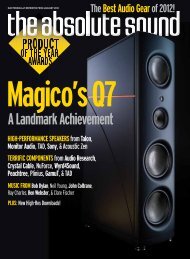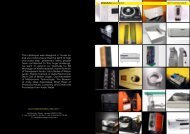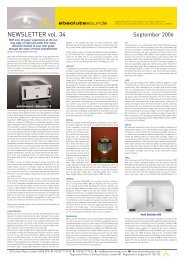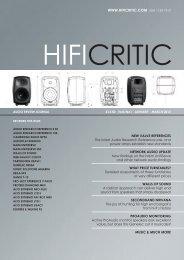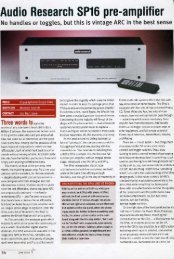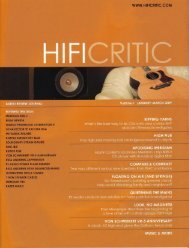loudspeaker - Absolute Sounds
loudspeaker - Absolute Sounds
loudspeaker - Absolute Sounds
Create successful ePaper yourself
Turn your PDF publications into a flip-book with our unique Google optimized e-Paper software.
GEnESIS OF THE XLF<br />
Last year, I was afforded the privilege of visiting the Wilson factory<br />
in Provo, Utah, when I became the first ‘outsider’ to hear the ‘nearly<br />
finished’ XLF side-by-side with the Alexandria. It was a test not<br />
only of one’s listening ability but of one’s capacity for dealing with<br />
differences that were neither better nor worse… just dissimilar. A<br />
direct descendant of the WAMM and its time alignment capabilities,<br />
the XLF was designed to extract even more from the Alexandria<br />
concept, while adding greater room matching flexibility thanks to<br />
a choice of rear or front ports. While hearing the side-by-side demo,<br />
I was impressed as much by the still-stunning performance of the<br />
Alexandria as I was by the seemingly subtle gains in the XLF. The<br />
session with the final XLF? Revelatory. KK<br />
refers to as the tweeter’s ‘noise<br />
floor’ – which, as I’d always supposed<br />
but have now had confirmed, is<br />
actually a reference to the speed<br />
of energy decay. Key to achieving a<br />
fast decay is careful absorption of<br />
the rear radiation from the dome<br />
so, like its predecessor, the new<br />
tweeter incorporates a damped<br />
rear chamber, which also reduces<br />
the stiffness of the enclosed air and<br />
so helps with keeping down the<br />
tweeter’s fundamental resonance<br />
frequency. Wilson’s literature doesn’t<br />
say so explicitly but it’s reasonable<br />
to suppose that the weightier silk<br />
diaphragm also helps suppress the<br />
effect of what little rear-radiated<br />
energy remains.<br />
InTEnSIvE LAbOUR<br />
Dave Wilson makes frequent<br />
reference to ‘dynamic contrast’<br />
and ‘harmonic expression’ when<br />
describing the qualities he strives<br />
for in his <strong>loudspeaker</strong>s, and in both<br />
respects the new Convergent Synergy<br />
tweeter is said to be an improvement<br />
over its predecessor. In addition, and<br />
perhaps not unrelated, it is claimed<br />
to have a flatter on-axis response,<br />
extending out to 33kHz, and bettercontrolled<br />
off-axis behaviour. Like the<br />
Series 2, the XLF also has a rear-firing<br />
tweeter, rolled in at about 15kHz,<br />
which adds extra treble ‘air’.<br />
The other major changes are at<br />
the opposite end of the frequency<br />
spectrum, in the bass. As already<br />
mentioned, the internal volume of<br />
the bass enclosure has increased by<br />
14%, despite which the XLF’s specified<br />
sensitivity has reduced by 1dB,<br />
although it still remains exceptionally<br />
high for a wide-bandwidth directradiating<br />
speaker, at 93.5dB. Wilson’s<br />
engineers have taken the opportunity<br />
of the revised cabinet dimensions to<br />
refine its complex construction still<br />
further, using laser interferometry<br />
to assess the results. As a result the<br />
cabinet is even more inert than<br />
the S2’s. You get some idea of the<br />
extensive vertical and horizontal<br />
cross-bracing used within from the<br />
CAD drawing on page 45, and from<br />
the fact that it takes a week of eighthour<br />
shifts to CNC machine all the<br />
pieces for just one enclosure.<br />
With over 500 pairs of Alexandria<br />
Series 2s now in the hands of owners<br />
around the world, Dave Wilson has<br />
had ample opportunity to hear the<br />
speaker working in a wide variety<br />
of rooms. It was as a result of<br />
noting that the S2 can sound a little<br />
bass-light in some environments –<br />
particularly where there is little soft<br />
furnishing acting as high frequency<br />
absorbent and the listening position<br />
is on the room centreline, where the<br />
null of the lowest width mode occurs<br />
– that he contrived the Cross Load<br />
Firing port system (which is what XLF<br />
stands for, not extra low frequency as<br />
you might have supposed).<br />
The concept is an essentially<br />
simple one – that the matching<br />
of the speaker to the room at<br />
low frequencies can be adjusted<br />
according to whether its reflex port<br />
exhausts forwards or backwards. So<br />
the XLF accommodates both options,<br />
by means of a removable panel and<br />
plug that can be used to block off<br />
the rectangular port mouth at either<br />
the front or rear of the enclosure. It’s<br />
a job of only a few minutes with a<br />
screwdriver to effect the change.<br />
KEn KESSLER LISTEnS<br />
A day with the Wilson XLFs, driven<br />
by darTZeel NHB-458 monoblocks:<br />
heady stuff for an intense listening<br />
Reprinted from Hi-Fi News & RR | www.hifinews.co.uk



